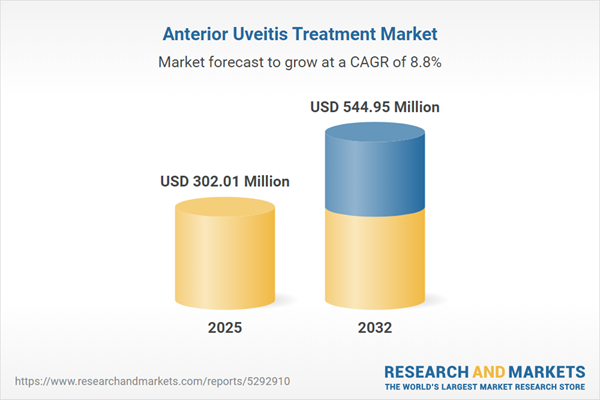Speak directly to the analyst to clarify any post sales queries you may have.
The anterior uveitis treatment market is undergoing rapid transformation, shaped by medical innovation, adaptive regulatory environments, and diverse clinical demands. Senior executives in pharmaceuticals, medical technology, and ophthalmology require market intelligence that supports clear, strategic action for long-term success.
Market Snapshot: Anterior Uveitis Treatment Market Size and Growth Rate
The anterior uveitis treatment market expanded from USD 277.28 million in 2024 to USD 302.01 million in 2025. Sustained by an 8.81% CAGR, it is projected to reach USD 544.95 million by 2032. This steady progression highlights a resilient environment, driven by breakthroughs in therapeutic approaches, increasing reliance on advanced biologics, and evolving regulatory policies across key jurisdictions.
Scope & Segmentation: Comprehensive Coverage of Treatment Pathways
This analysis delivers a detailed assessment of the anterior uveitis treatment market, focusing on critical segments and next-generation technologies that enable differentiated patient care:
- Treatment Types: Non pharmacological treatments such as laser therapies and surgical interventions, as well as pharmacological approaches including biologics, corticosteroids, immunosuppressants, and NSAIDs, facilitate tailored regimens for various clinical scenarios.
- Drug Classes: Biologics, corticosteroids, immunosuppressants, and NSAIDs range from broad-spectrum agents to precision-targeted therapeutics, offering decision-makers flexibility in managing inflammation and recurrence.
- Routes of Administration: Intravitreal, periocular, systemic, and topical delivery systems provide adaptability for clinicians, supporting both acute interventions and sustained management based on patient needs and tolerability.
- Distribution Channels: Hospital pharmacies, online and retail pharmacies structure the accessibility landscape, ensuring treatment is available across both institutional and community-based settings, and aligning with evolving patient behavior.
- End Users: Ambulatory surgery centers, clinics, and hospitals contribute to procedural diversity and drive distinct patient management strategies, shaping adoption rates and influencing formulary inclusion.
- Geographical Regions: The report includes targeted analysis of the Americas (United States, Canada, Mexico, Brazil, Argentina, Chile, Colombia, Peru), Europe, Middle East & Africa (UK, Germany, France, Russia, Italy, Spain, Netherlands, Sweden, Poland, Switzerland, UAE, Saudi Arabia, Qatar, Turkey, Israel, South Africa, Nigeria, Egypt, Kenya), and Asia-Pacific (China, India, Japan, Australia, South Korea, Indonesia, Thailand, Malaysia, Singapore, Taiwan). This regional focus underscores the variability in market access and clinical practice.
- Companies Profiled: Market leaders and innovators profiled include AbbVie Inc., Novartis International AG, Bausch Health Companies, Alcon Inc., Santen Pharmaceutical, Pfizer, Sun Pharmaceutical, Fera Pharmaceuticals, Clearside Biomedical, and Imprimis Pharmaceuticals. These organizations drive advancements in therapy, delivery systems, and overall standard of care.
Key Takeaways for Senior Decision-Makers
- Pioneering biologic therapies and state-of-the-art drug delivery platforms are reshaping anterior uveitis management, enabling more individualized approaches focused on improved long-term disease control.
- Technological innovation, including developments like nanoparticle drug formulations and sustained-release implants, is increasing treatment adherence and minimizing systemic side effects in recurring or resistant patient populations.
- Regional patterns in prescribing and clinical outcomes are directly impacted by local regulatory directives, supply chain strength, and investment in manufacturing infrastructure, which collectively shape access and adoption rates.
- Ongoing cross-sector collaborations, alongside robust real-world data integration, are accelerating translational research and influencing updates to clinical guidelines, fostering a more agile response to emerging therapeutic evidence.
- The expansion of hospital and community-based care models is driving strategic shifts in distribution practices, product portfolio positioning, and engagement strategies among all stakeholders across the market.
Tariff Impact: Evolving Trade Policies Affecting Market Dynamics
Recently changed United States tariffs have altered sourcing models for ocular therapies, adjusting both domestic and international supply networks. Manufacturers are now investing in more resilient logistical strategies, partnering with specialized freight and cold-chain providers to ensure stable supply. These measures help protect patient access and preserve cost consistency, particularly as regulatory documentation and delivery lead times present new challenges for ongoing market stability.
Methodology & Data Sources
This report combines quantitative and qualitative methodologies, synthesizing data from peer-reviewed publications, regulatory databases, clinical trial registries, and direct interviews with ophthalmology experts, pharmaceutical leaders, and healthcare professionals. Triangulation of insights provides a reliable, comprehensive analysis of patient and provider trends in this market.
Why This Report Matters
- Offers segmented trend analysis to support strategic portfolio management and proactive response to anticipated market changes.
- Provides senior leaders with practical, real-world perspectives to inform decision-making related to resource planning, product innovation, and channel strategies in multiple geographies.
- Informs risk assessment and opportunity identification amid regulatory, technology, and trade policy developments, facilitating effective adaptation in a dynamic market.
Conclusion
With strong clinical, technological, and regulatory trends converging, the anterior uveitis treatment market demands agile strategic responses. Access to forward-focused analysis positions stakeholders to foster innovation and sustain competitive relevance.
Additional Product Information:
- Purchase of this report includes 1 year online access with quarterly updates.
- This report can be updated on request. Please contact our Customer Experience team using the Ask a Question widget on our website.
Table of Contents
3. Executive Summary
4. Market Overview
7. Cumulative Impact of Artificial Intelligence 2025
List of Figures
Samples

LOADING...
Companies Mentioned
The key companies profiled in this Anterior Uveitis Treatment market report include:- AbbVie Inc.
- Novartis International AG
- Bausch Health Companies Inc.
- Alcon Inc.
- Santen Pharmaceutical Co., Ltd.
- Pfizer Inc.
- Sun Pharmaceutical Industries Ltd.
- Fera Pharmaceuticals LLC
- Clearside Biomedical, Inc.
- Imprimis Pharmaceuticals, Inc.
Table Information
| Report Attribute | Details |
|---|---|
| No. of Pages | 182 |
| Published | October 2025 |
| Forecast Period | 2025 - 2032 |
| Estimated Market Value ( USD | $ 302.01 Million |
| Forecasted Market Value ( USD | $ 544.95 Million |
| Compound Annual Growth Rate | 8.8% |
| Regions Covered | Global |
| No. of Companies Mentioned | 11 |









